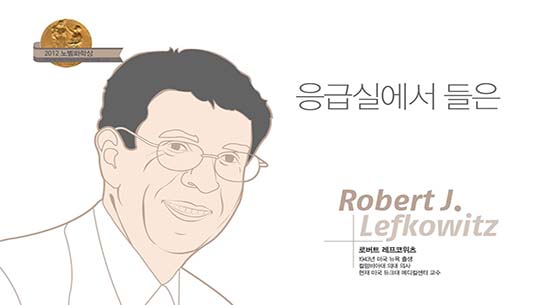5월 자국의 내전 등을 피해 제주도에 입국한 예멘인 약 500명이 한꺼번에 난민 신청을 하면서 우리와는 무관할 것만 같았던 난민 이슈가 사회적 논쟁거리로 부상했다. 예멘 난민 수용을 반대한다는 여론과 난민법을 적용해 수용해야 한다는 목소리가 동시에 나왔다. 7월 13일까지 진행된 난민법 개정에 대한 청와대 국민청원에는 70만 명이 참여했다.
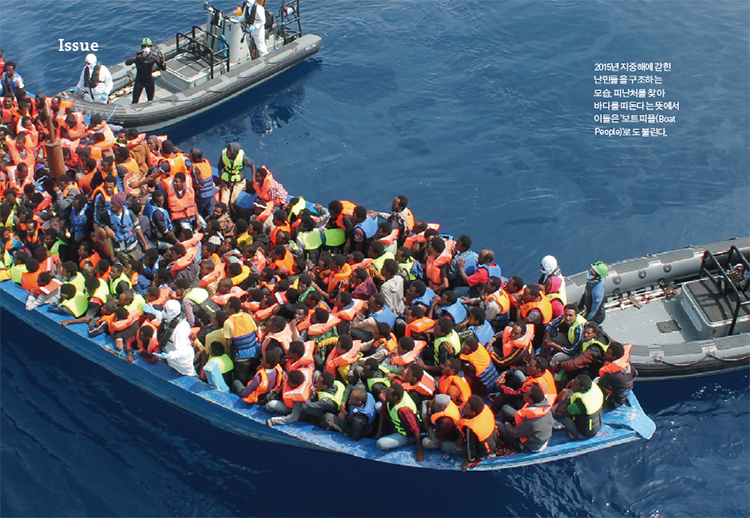
‘난민은 박해나 전쟁, 폭력을 이유로 자국을 떠나도록 강요받은 사람이다’.
유엔(UN)이 규정한 난민에 대한 정의다. 2012년 제정된 국내 난민법도 이 기준에 따라 난민을 규정한다. 우리나라는 1992년 유엔난민협약에 가입했고, 1994년 난민 신청을 받기 시작한 이후 2017년까지 외국인 792명에게 난민 지위를 인정했다. 심사를 받은 외국인 1만9424명 중 인정비율은 4.1%에 불과하다.
국내 난민 신청자는 2011년 처음 1000명을 돌파한 뒤, 지난해 9942명으로 가파르게 증가했다. 2016년 기준 세계 난민 수는 6560만 명에 이른다.
그간 과학계에서는 난민에 관한 연구결과를 여럿 발표했다. 이들 결과는 난민 정책을 세우는 자료로 활용될 수 있다. 연구결과를 토대로 난민에 관한 과학적 팩트 네 가지를 정리했다.
팩트 1. 최적의 정착지는 난민마다 다르다
우리보다 일찍 난민을 수용하기 시작한 미국, 유럽 등은 난민 지위가 인정된 외국인의 거주지를 무작위로 배정하고 있다. 하지만 최근 미국 스탠퍼드대, 스위스 이민정책연구소, 영국 런던정치경제대 등 국제공동연구진은 난민 신청자의 국적, 나이, 구사가능 언어 및 기술 등에 따라 최적의 정착지가 다르다는 연구결과를 발표했다. 연구진은 난민 신청자에게 최적의 정착지를 제안하는 알고리즘을 개발해 국제학술지 ‘사이언스’ 1월 19일자에 실었다.doi:10.1126/science.aao4408
스위스의 경우 독일어를 쓰는 지역(예를 들면 취리히)과 프랑스어를 쓰는 지역(제네바)으로 나뉜다. 만약 프랑스어를 구사하는 난민이 입국한다면, 제네바 지역으로 배정하는 것이 합리적이다.
하지만 현재 정책 상 난민이 어느 지역으로 배정될지는 그 사람의 능력이나 기술과 상관없이 무작위로 결정된다. 개인의 성향이나 능력에 따라 거주지를 배치한다면 난민의 정착과 해당 지역사회에 미치는 긍정적 효과를 모두 높일 수 있다.
이런 가정에서 시작한 알고리즘의 원리는 간단하다. 같은 국가 출신, 비슷한 나이, 비슷한 언어 구사 능력을 가진 두 명의 난민 A, B가 서로 다른 지역에 배정됐다고 가정하자. A는 직장을 구해 경제활동을 하는 반면, B는 실업자다.
알고리즘은 이런 정보를 학습한 뒤, 향후 이들과 배경이 비슷한 새로운 난민이 유입될 경우 A의 거주 지역으로 배정하라고 권유한다. 연구진은 이 기술을 활용해 난민의 취업률을 최대 70%까지 올릴 수 있을 것으로 예상했다.
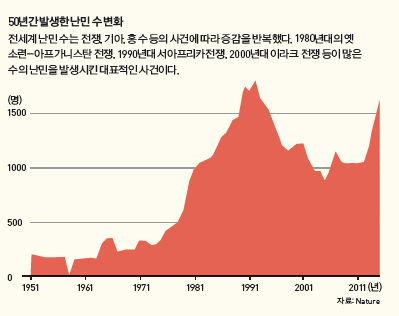
연구진은 2011~2016년 미국에 들어온 18~64세 난민 3만 명의 통계자료를 분석했다. 이후 2016년 말 난민 신청자를 대상으로 이 알고리즘을 적용해 최적의 정착지를 조사했다. 이 기간 난민 신청자의 실제 취업률은 25%에 불과했지만, 최적의 정착지에 배치된 경우 예상 취업률은 50%로 두 배가량 높았다.
또 연구진은 1999~2013년 스위스에 입국한 난민신청자의 정보를 분석하고, 2013년 이들 신청자를 대상으로 동일한 분석을 반복했다. 해당 기간 실제 취업률은 15%에 불과했지만, 알고리즘의 결과에 따라 최적의 정착지에 배치된 경우에는 예상 취업률이 26%로 증가했다.
제레미 와인스타인 미국 스탠퍼드대 정치학과 교수는 “그간 난민 문제에서 유입 여부에 대한 관심만 많았을 뿐, 난민 지위가 인정된 이들이 정착 이후 사회에 미치는 영향에 대한 고려는 상대적으로 적었다”며 “이번 연구결과는 개인의 특성을 고려해 난민을 배치할 경우 난민과 지역사회가 서로 ‘윈윈’하는 전략을 세울 수 있음을 보여준다”고 말했다.

팩트 2. 난민이 경제에 부담을 주진 않는다
많은 사람들이 난민 유입을 거부하는 이유 중 하나는 난민수용에 따른 경제적인 부담이다. 하지만 프랑스 국립과학연구원(CNRS)이 클레르몽 오베르뉴대, 파리 낭테르대와 공동으로 연구한 결과에 따르면 난민이 경제에 오히려 긍정적인 영향을 주는 것으로 밝혀졌다. 연구결과는 국제학술지 ‘사이언스 어드밴시스’ 6월 20일자에 실렸다.doi:10.1126/sciadv.aaq0883
연구진은 유럽연합통계청(Eurostat)과 경제협력개발기구(OECD)가 제공한 1985~2015년 경제 전망 자료를 토대로 이 같은 결론을 냈다. 연구진은 서유럽 15개국(네덜란드, 노르웨이, 덴마크, 독일, 벨기에, 스페인, 스웨덴, 아일랜드, 아이슬란드, 영국, 오스트리아, 이탈리아, 포르투갈, 프랑스, 핀란드)을 대상으로 난민 신청자와 이들로 인해 발생하는 경제적 효과를 분석했다.
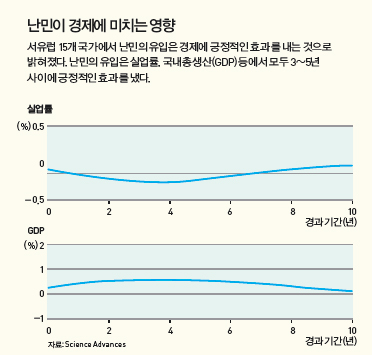
분석 결과 난민 신청자들이 난민 지위를 인정받아 경제활동을 시작하고 3~5년(평균 4년)에 걸쳐 긍정적인 효과가 나타나는 것으로 확인됐다. 난민 지위 인정 뒤 2년을 기준으로 1인당 국내총생산(GDP)은 0.54% 포인트 높이고, 실업률은 0.21% 포인트를 하락시키는 효과를 냈다. 세수는 1.01% 포인트 끌어올린 것으로 나타났다.
연구진은 이런 효과가 나타나는 이유를 난민 대부분이 청년과 중장년층이어서 고령화로 부족한 산업 인력을 보충하고 현지인이 기피하는 3D 업종에 투입되기 때문이라고 설명했다.
히포리트 달비스 CNRS 파리경제대학원 교수는 “난민이 경제에 긍정적인 효과를 내기까지는 어느 정도의 시간이 필요하지만, 적어도 부정적인 영향을 주는 것은 아니라는 점이 확인됐다”고 말했다.
팩트 3. 난민의 비율은 점점 줄고 있다
최근 난민 문제가 가장 주목받은 시기는 2015년이다. 시리아 내전으로 발생한 난민들이 대거 유럽으로 향했기 때문이다. 2130만 명의 난민이 발생했고, 각종 통계는 ‘기록적으로 많은 난민이 발생한 해’로 기록했다.
하지만 인구 증가율에 비하면 난민이 증가했다고 말하기는 어렵다. 국제학술지 ‘네이처’는 지난해 3월 난민문제를 특집으로 다루면서 이런 점을 지적하며, 통계의 허점으로 난민에 대한 걱정이 과도하게 높아지고 있다고 꼬집었다.doi:10.1038/543022a
2015년 발생한 난민은 1990년대 이라크 전쟁으로 발생한 2260만 명과 유사한 수준이지만, 당시 세계 인구는 오늘날의 3분의 2에 불과했다. 인구 70억 명 시대와 인구 50억 명도 안 되던 시대를 비교하면 단연 후자가 난민이 더 많이 발생한 셈이다.
또 사람들은 난민이 북미와 유럽으로 주로 향할 것이라고 생각하지만, 실제로 난민이 이동하는 나라는 전 세계에 걸쳐있는 것으로 분 석됐다. 1 990년대와 2000년대에는 멕시코에서 미국으로 이동하는 난민 수가 가장 많았고, 2010년대에는 시리아에서 터키나 레바논으로 이동하는 수가 가장 많았다.
가이 아벨 오스트리아 빈 인구통계연구소 연구원은 “최근 사상 최대 규모의 난민이 발생하는 것처럼 알려져 있지만, 오히려 전체 인구 대비 난민의 비율은 지금이 50년 만에 최저 수준”이라고 말했다.
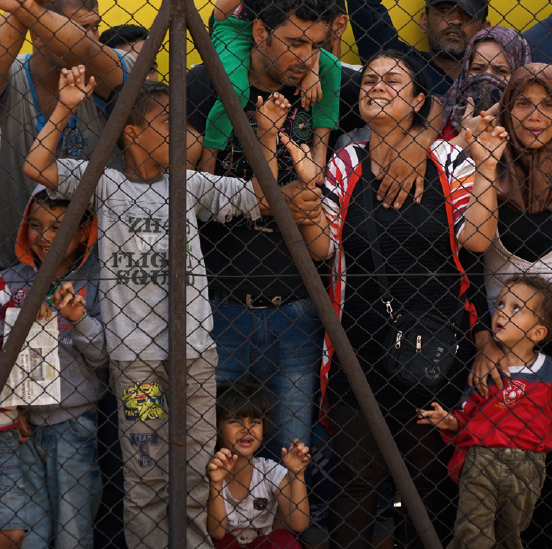
팩트 4. 기후변화로 인한 난민 발생한다
난민을 정의하는 박해에는 인종과 종교, 국적, 특정사회집단 구성원, 정치적 의견 등 다섯 가지가 포함된다. 하지만 1980년대 이후 ‘기후 난민’도 주목을 받고 있다.
기후 난민은 일반적인 난민과는 차이가 있지만, 자신의 거주지가 위협받고 결과적으로 자국에서 살 수 없어 타국으로 이동한다는 공통점이 있다.
역사적으로 홍수, 폭우, 가뭄, 냉해, 이상고온 등의 이상 기후는 내전을 포함한 전쟁, 기아, 난민의 전조증상이었다. 이중 가장 시급한 것은 해수면 상승으로 인한 문제다. 가령 신혼여행지로 각광받는 몰디브는 현재 지면이 해수면보다 딱 1.5m 높다. 지구온난화로 해수면이 조금만 더 상승해도 몰디브는 바다 속으로 사라지고, 몰디브 국민 44만4000여 명은 살 곳을 잃은 기후 난민이 된다.
몰디브뿐만이 아니다. 카리브해와 태평양 섬나라들의 경우 인구의 50% 이상이 해안선으로부터 1.5km 이내에 살고 있어 해수면 상승에 따라 기후 난민이 될 위험이 높다. 기후 난민은 비단 섬나라에만 해당되는 이야기가 아니다. 홍수, 폭풍우, 가뭄 등 기후 관련 재해는 지난 20년간 두 배 증가했고, 이를 고려하면 2050년 세계 인구로 추정되는 90억 명의 1.5%인 1억 명이 잠재적 난민이다.
한편 리처드 시거 미국 컬럼비아대 교수팀은 시리아 내전으로 빚어진 대규모 난민 사태의 근본적인 원인이 기후변화에 있다는 연구결과를 2016년 ‘미국국립과학원회보(PNAS)’에 발표하기도 했다.doi:10.1073/pnas.1614342113
연구팀은 과거 100년 동안 시리아의 기온, 해수면, 기압 등을 분석했다. 그 결과 2007년부터 시작된 사상 최악의 가뭄으로 농사를 지을 수 없게 된 농민들이 한꺼번에 도시로 몰려들었고, 이는 인구 수용 한계치를 넘어선 도시의 가난, 범죄 등 사회문제로 이어졌다. 결국 기후변화가 사회를 교란시켰고, 이로 인해 내전이 발생했다는 주장이다.
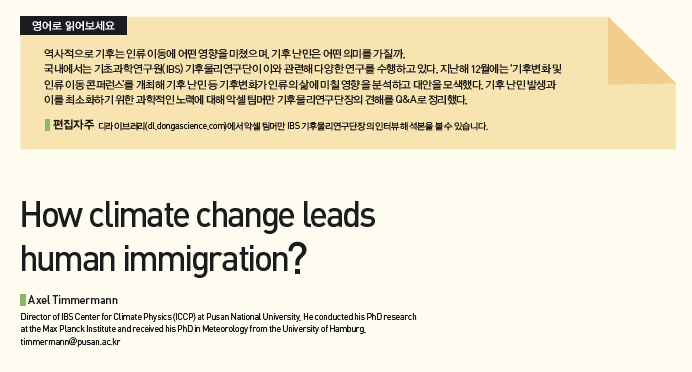
Q. Is there any historical evidence that climate change has led to human migration?
Local temperature and rainfall conditions largely determine the type of plants that can grow in a particular region. Carbon stored in plants - in the form of a variety of organic molecules - is the basic food source for animals and eventually humans. Areas with large terrestrial carbon accumulation, can therefore support more individuals and high population densities.
As climate changes, also vegetation zones can shift, which in turn induces migration pressure or opens up new green and habitable regions. One prominent example is the periodic drying and greening of northern Africa, which allowed Homo sapiens to move from Central Africa into the Arabian Peninsula and eventually into Eurasia about 120-60 thousand years ago. These vegetation cycles were induced by the wobble of earth’s axis with a period of about 20000 years, which caused changes in the seasonality of solar radiation and shifts in temperature and rainfall patterns. In this regard our species, which has managed to settle in the most remote locations and adapt to the harshest climatic conditions, is a migratory species.
Q. What ‘Climate Refugees’ mean and how do they differ from ordinary refugees?
Whereas humans had to adapt to naturally occurring climate changes for the past tens of
thousands of years, our species has now began to alter the pace of these changes, by rapidly emitting greenhouse gases which in turn warm our planet. Man-made Global Warming is already inflicting additional climatic stress on societies and ecosystems. With sea levels rising, low lying islands such as the Maldives in the Indian Ocean, the Marshall Islands and Tuvalu in the Western Pacific already experience increased frequencies of inundation, loss of coastline and agricultural land.
Inhabitants of these islands will most likely become the first people to loose not only their livelihood and culture, but also their land and in some cases even their country. With Island Nations disappearing, our global society has to come together to develop mechanisms to accept displaced people as climate refugees and provide shelter and new land for them. However, defining a climate change refugee and potentially establishing an asylum status for affected people has been very difficulty, as man-made climate change and naturally occurring climate and weather events, as well as deteriorating economic and political conditions can all
play a role in someone’s decision to leave home and migrate to another country.
Q. How will human immigration change due to climate change?
The human densit y (nowadays) is controlled by many factors, only one of them is climate. It is estimated that sealevel rise and other effects of global warming may generate up to a few hundred million climate migrants by the end of this century.
Many of them may find a new home in their own country. Yet, others may have to leave their country to survive or support their families. Climate-induced displacement may cause ethnic and cultural conflicts. Coping with this self-inflicted problem, our global society has to come up with means to mitigate climate change effectively and to develop international plans for resettlement of climatechange victims.
Another important issue is the effect of Global Warming on crops and global food security. Current estimates suggest that every degree of Global Warming will reduce global food production by 8-10%. In areas such as India, South Africa and the Middle East, this will translate to 30-40% reduction over the next 80 years.
Food prices are likely to soar, causing economic distress to these regions which will further exacerbate the migration pressure. This also highlights that climate change can be an initial trigger of economic problems.
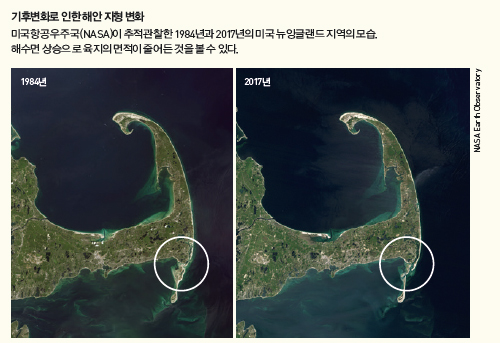
Q. What efforts have been made to minimize damage caused by climate change?
Taking the targets of the Paris agreement seriously and cutting down aggressively on greenhouse gas emissions to limit Global Warming to below 2℃ (above pre-industrial levels) is the first step to manage climate change impacts on societies and food resources.
Human migration will always take place and it has been extremely beneficial for our species. However, the issue of climate-change induced migration is totally different, as it involves people who have been in severe distress and oftentimes require higher level of financial support and social care from their hosting countries.
Whether a society is willing to accept foreigners under these circumstances depends very much on its available economic resources, the cultural openness of the host country and the recognition that many climate refugees are forced to leave their home, because of the rapid economic development (and greenhouse gas emissions) of a few highly industrialized nations. Without a concept of global responsibility, there will not be a solution to the emerging climate refugee crisis.









